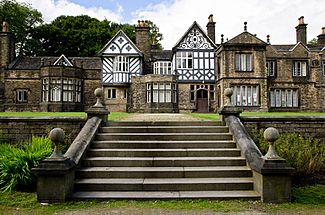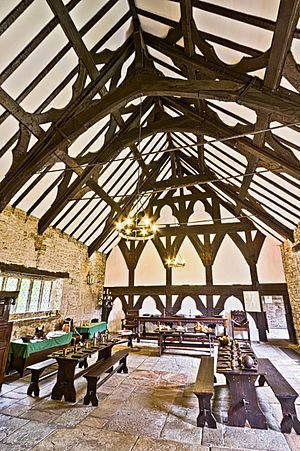Smithills Hall facts for kids
Quick facts for kids Smithills Hall |
|
|---|---|

Smithills Hall
|
|
| Type | Manor house |
| Location | Smithills, Greater Manchester, England |
| Built | 14th–19th century |
| Architectural style(s) | 14th century half-timbered hall house extended several times. |
| Owner | Metropolitan Borough of Bolton |
|
Listed Building – Grade I
|
|
| Official name: Smithills Hall | |
| Designated | 23 April 1952 |
| Reference no. | 1388279 |
| Designated | 12 November 1991 |
| Reference no. | 43437 |
| Lua error in Module:Location_map at line 420: attempt to index field 'wikibase' (a nil value). | |
Smithills Hall is a very old and important house in Smithills, Bolton, Greater Manchester, England. It is known as a manor house, which is a large country house that was once the main home of a lord or wealthy family. It is also a scheduled monument, meaning it is a nationally important historical site.
The hall sits on the hills of the West Pennine Moors, about 3 miles (5 km) north-west of Bolton town centre. It was built in a good spot for defense, near two brooks. Smithills Hall is one of the oldest manor houses in North West England. Its oldest parts, like the great hall, were built in the 1400s. Over the years, it has been changed and made bigger, especially the west side. Some parts of the hall used to be surrounded by a moat, which was a deep, wide ditch filled with water for protection. Today, Bolton Metropolitan Borough Council owns the property, and it is open for people to visit.
Contents
History of Smithills Hall
The name Smithills comes from old English words meaning "smooth hill." The hall's history began in 1335 when William Radcliffe took over the manor. The Radcliffe family lived there until 1485. After that, the Bartons, who were rich sheep farmers, owned Smithills Hall for almost 200 years.
In 1659, the hall became part of the Belasyse family through marriage. Later, in 1722, the Byrom family from Manchester bought the manor. They kept it until 1801. Then, the Ainsworth family, who made their money from bleach factories, bought the hall and its land. Around 1875, Richard Henry Ainsworth hired an architect named George Devey to make the hall bigger and more modern.
In 1938, the Ainsworths sold Smithills Hall to Bolton Corporation (now Bolton Council). Parts of it were used as a home for older people and a day centre, which closed in the 1990s. The oldest parts of the hall opened as a museum in 1963. In the 1990s, the museum grew to include some of the newer Victorian parts. The west side of the hall was fixed up by the council in 1999. The "Devey Room" was fully updated in 2018. Since 2017, there has also been a Poppins at Smithills tea room on the ground floor, which is themed around the character Mary Poppins.
In 1554, a preacher named George Marsh was questioned at Smithills Hall. He was later sent to Chester to be tried for believing things that were different from the official religion of the time. He was found guilty and put to death in Chester. There is a footprint at Smithills Hall that people say was left by Marsh. The legend says it bleeds every year on the day he died, April 24.
Nathaniel Hawthorne, a famous American writer, visited Smithills Hall in 1855. He was working as the United States consul in Liverpool at the time and wrote about the hall.
The Winter Hill Mass Trespass
In 1896, a large group of 12,000 people took part in a "mass trespass" at Winter Hill. This happened because Colonel Henry Ainsworth, who owned the land around Smithills Hall, had blocked off a path called Coal Pit Road. This road was a very important route for people to get from Bolton to the countryside. Many people used it to escape the dirty towns and difficult working conditions of the time.
When Colonel Ainsworth blocked the path, the public broke down the gate to show that they wanted access to the moorland. This event was a strong protest for public access to the countryside. It is remembered with a stone on Coalpit Road. This event was similar to the Kinder Scout mass trespass, which happened later. By 1996, Coal Pit Road was officially made a public right of way, meaning everyone has the right to use it.
Architecture of the Hall
Smithills Hall is built on a flat area, surrounded by parkland. It is located on the south side of a valley with a steep slope. The hall has three main sections built around an open courtyard.
The oldest part of the building is the great hall, which was likely built in the early 1300s. This part of the hall was once surrounded by a moat. Even though it has been changed over time, it still has its original layout and many old features. The oldest parts were built with wooden frames, and the oldest stone parts are made of rough, uneven stones. The west side of the hall, which was built in the 1800s, is made of squared stones and has decorative wooden beams. All the roofs are covered with stone tiles.
Park and Gardens
The gardens and pleasure grounds around Smithills Hall cover about 48 hectares (118 acres). They are on a south-facing slope at the edge of the moorland. To the north, there is a steep, wooded valley and a lake. Around the hall itself, there are more formal gardens.
See also
- Grade I listed buildings in Greater Manchester
- Scheduled Monuments in Greater Manchester
- Listed buildings in Bolton
- Petrosomatoglyph






